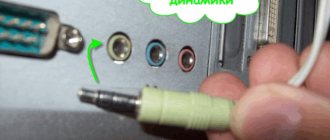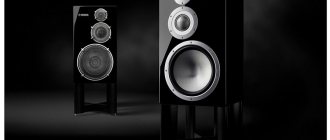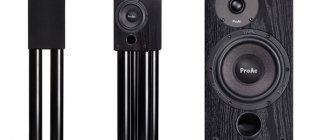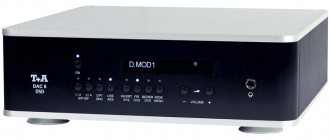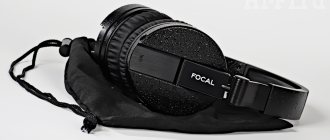People who have connected their lives with sound recording pay great attention to equipment for listening to audio material. Identifying defects that occurred during recording of vocals or instruments is a vital task for them. It is not possible if you use regular speakers or headphones. This is due to the fact that during playback the sound quality improves, making it as comfortable as possible for the ear. Manipulations distort the starting parameters of the composition. However, in another speaker system the sound will be completely different. It is possible to avoid such problems by achieving the correct musical balance, which is achieved through mixing and mastering. Experts note that in certain areas of the sound canvas, headphones will help to recognize problems with the formation of timbre and identify resonance. But for quality work, you need to think about purchasing studio monitors.
Features of studio monitors
In organizing a home studio, they come in second place after a sound card. Represents speaker systems that reproduce audio material without distortion. They are characterized by low power and a smooth amplitude-frequency response (AFC). The latter is critically important for professional recording studios. With their help, they monitor the balance of instruments, sound quality and recording (during performance). In other words, their task is to convey sound in its original state, without any distortion or embellishment. A professional studio monitor is a unique idea, materialized thanks to experienced designers and engineers. The materials used for manufacturing are advanced soundproofing and sound-absorbing acoustic materials. All components are subject to strict requirements:
- the speakers are accurate with a correctly calculated frequency response (“sound dips” and “blockages” are excluded!);
- class A circuitry;
- design and housing taking into account the laws of physics and acoustics;
- low-frequency speakers (LF) are made of reinforced fiberglass, polypropylene, Kevlar, impregnated paper and cellulose;
- high-frequency speakers (HF) - made of aluminum foil, paper, titanium, beryllium.
Based on the above, there is a significant difference between monitors and a home audio system. All this is necessary to reproduce audio material exactly as it was intended. Placement is of great importance, taking into account all the laws of acoustics. This is the only way the music will fill all the space between, and not from a specific speaker.
The equipment is necessary for those who are thinking about creating a home or professional studio. Indispensable for specialists involved in mixing tracks or vocals. Using simple speakers to listen to music is not the best solution. Since the resulting sound will not always be clear and beautiful, as we would like. In most cases, monitors are not used on stage.
Acoustic stands
In any case of placing acoustics in a room, the speakers must be placed on some surface, with some sound-absorbing material placed under it, even thick foam rubber will do (from the packaging of the same acoustics). Many people use special stands, but mostly standard rubberized legs are used.
You should not embed the so-called “spikes”; this option is not entirely suitable for using monitors and bookshelf speakers. More “spikes” are suitable for large, massive floor-standing speaker systems complete with a monolithic slab of marble or simple strong concrete.
The ideal installation would be the case in which you can get some forward tilt of the acoustics. This can be a professional monitor stand or a homemade stand with an inclined plane. The tilt may not be necessary, but such versatility will not make it worse. After all, a person of a different height may be at the desk in front of the monitors, and he can easily adjust the acoustics to suit himself.
But it’s easier to place studio monitors on stands exactly at head level, and then you may not even need the option with inclined stands. The cost of such stands may be completely beyond your wallet, then you need to think about a more budget-friendly option - installing monitors on a table surface or homemade stands, which can be made of both metal and wood. There is no time for beauty here anymore. But everything is in your hands! It may not be as difficult as it seems.
If the room is small, the acoustics are installed on a table, and the furniture is also small (tabletop), then installing monitors on stands is not always possible. But if the room is more than 20 square meters, then racks are simply necessary. They will provide more opportunities for correct installation of acoustics when conducting “military operations” with standing waves.
How it works
All parts are enclosed in a housing, which is also called a cabinet. Made from wood, plastic, metal, MDF. As a rule, they are equipped with two speakers.
- Twitter reproduces high frequencies above 2 kHz. It has a cone shape. Placed at the top The material used varies by manufacturer;
- woofer, large speaker reproducing low and mid frequencies up to 2 kHz.
Some models have an additional speaker responsible for playing mid frequencies. An electromagnet is installed behind them; its task is to move the speakers using vibration. In this way a sound wave is obtained.
Most monitors are equipped with a phase inverter; it amplifies the low-frequency component of the signal. This is a hole with a pipe placed in the housing, it removes the pressure that is created inside the woofers. The shape and dimensions of the bass reflex vary depending on the manufacturer. It is located at the back or front of the panel.
Vertical or horizontal?
You will find the answer to this question in the instructions for your specific monitors. Manufacturers recommend installing some models only vertically, while others allow horizontal installation. Typically, studio monitors are placed vertically, which is due to the fact that horizontally placed monitors narrow the stereo sound image.
The main rule when placing monitors is mirroring. When positioned horizontally: tweeters facing out, woofers facing each other. When positioned vertically: also mirrored, with woofers down and tweeters up.
But do you remember that the main thing in finding great sound is experimentation? Break the system and try to install what should be there, and vice versa, and also install monitors with tweeters down. Try, listen, based on the characteristics of the room, monitors and your hearing.
Active or passive monitor?
In order for the equipment to reproduce audio material, it must be amplified. Depending on the method used, there are:
Active
Equipped with built-in amplifiers, crossovers and everything necessary for normal functioning. Separate models with 2 amplifiers for low and high frequencies. All available connectors and inputs are installed on board: Canon, jack, tulip (XLR, TRS, RCA). There are devices with digital optical inputs.
Advantages:
- unlimited possibilities of use;
- use regardless of input type (digital or analogue);
- no need to purchase an amplifier;
- adapt to the room in which they are used;
- Properly selected circuit design reduces the risk of burning out the speakers and amplifier.
Flaws:
- a large number of wires;
- complex design requires qualified specialists;
- The sound engineer does not have the ability to change the volume level from the workplace.
Passive
Need an amplifier. It has a simple design. Due to the need to purchase additional equipment, as well as the presence of one input (analog, acoustic, or line mono jack), they did not become popular. The sound quality is affected by: the selected amplifier, the connecting cables used and the connectors used.
Advantages:
- easy installation;
- only 1 wire;
- no additional built-in equipment is provided;
- simple repairs and diagnostics;
- the organization of the acoustic space was approached with due attention;
- the sound engineer can adjust the volume at the workplace.
Flaws:
- you need to purchase an amplifier;
- analog input (acoustic or linear);
- monolithic installation;
There are ongoing disputes among experts about who should take the palm. Each group has undeniable advantages and disadvantages. There is an opinion that devices that perform only one function cope better with it than multitasking ones. Looking back at this, some people prefer passive studio monitors. But technology does not stand still; the efficiency of combined devices has increased significantly. This gave talented people the opportunity to record material in studio quality without leaving home for reasonable money.
How to get the highest quality sound? Audio card is a solution to problems.
I will not delve into the system characteristics of laptops and computers, and the main source for many is these media, but this point needs to be touched upon.
Almost all laptops, as well as self-assembled desktop PCs, do not have on board the high-quality equipment that music lovers need. Especially when you plan to use expensive monitors, there’s no way to get by with “standard audio speakers.” The same professional approach is needed here. If you bought expensive monitors or good bookshelf speakers and want to get the appropriate sound, provide them with high-quality sound even before approaching them.
If you use a computer as a sound source, and it does not have a good sound card that has digital outputs, coaxial, midi interfaces and AES/EBU and the like, then you need to purchase an appropriate or external audio card. Which one is up to you, the choice is huge. Also, the desired needs from this card are very different.
But if you have nothing at all except a laptop, even a new one, then there is no point in thinking about buying studio monitors. They are far from cheap. And if you connect them to the built-in card of the computer, then you will definitely not get the desired effect from them.
What are they?
Professional studios are equipped with several lines. Location influences purpose.
- Near field. The most common group. Placed on the sound engineer's table or special stands. They are characterized by high-quality transmission of mid and high frequencies. Without them it is impossible to mix a track or edit a soundtrack
- Middle field. They help create acoustic effects that cannot be recognized up close. Reproduce low frequencies. As a rule, three-way models are used for mixing audio material.
- Far field. They listen to the resulting composition and the album as a whole at any volume level and in all frequency ranges. Used in large studios, for mastering and working with dance music.
Subwoofer
The subwoofer will make the low frequencies more expressive and the sound richer. But before using it, you need to set up the monitors very well, positioning them correctly. The subwoofer should naturally complement the sound of the monitors, and not shake it. The great news is that the subwoofer can be installed almost anywhere in the room, but preferably in line with the monitors to minimize signal phase issues.
And experiment again: place the subwoofer in the same plane as the monitors and listen to how the low frequencies sound. Then adjust the position of the sub, for example, if the bass is too powerful, move it further to the sides. Low-frequency sound does not propagate directionally, but seems to fill the entire space, which is what determines the variety of placement of the subwoofer. But there are still some recommendations for the location of the subwoofer: avoid corners and resonating surfaces.
To summarize the above, focus primarily on hearing. Considering monitor placement recommendations, listen to how the music mix sounds: how clean and full. Experiment, search and enjoy music!
How to check before buying?
To make the right choice, knowing the characteristics of monitors alone is not enough. The ears themselves play an important role. Any indicators pale before the fact that the equipment that interested the specialist does not sound good. The studio people are sure to listen! Before starting this process, you should ensure that it technically fully meets the expected requirements. Listening will bear fruit if you follow simple rules.
- Use only familiar, high-quality recordings. This is the only way to fully appreciate the sound quality.
- Listen at different volumes. The sound does not change depending on the volume level.
- Trust your own intuition. If listening did not provide an understanding of all the subtleties of the performance and did not allow one to distinguish between resonances and distortions, and the audio file seemed balanced, you need to pay attention to other monitors.
Criterias of choice
Many experts lay out recommendations on how to choose a device worthy of attention and which company is better. You can first review the ratings of quality products and read user reviews. Advice on choosing is the right thing to do. But still, it is necessary to rely on individual preferences. The best product is the one you feel passionate about, regardless of how much it costs or whether it is a best-selling product.
But there are some nuances that are worth listening to, and they are as follows:
- Choose a few melodies that you know thoroughly. Try to keep them in the same style and genre with which you will be working. The quality must be at the highest level. The recordings should be transferred to a CD. A flash drive will do. Take your devices with you to the store. It would be useful to have discs for testing, thanks to which you can understand the features of reproduction that are beyond the reach of ordinary hearing.
- Choose a location to place the structures. Take a tape measure, blank sheets of paper and pencils as assistants. Draw a schematic floor plan of the room. Take measurements of all parameters: between the products and the wall, between each monitor, operator and listeners. If you have to install elements in close proximity to the wall, then you should give preference to the front location of the bass reflex. If there is a distance of 30 - 40 centimeters from the wall, you can take devices with a rear bass reflex, which will allow you to calculate the possibility of the highest quality bass processing.
- Pay attention to the monitor type. Popular companies produce desktop, floor-standing, mid-field and near-field models. It is worth remembering that there are differences in the location of the bass reflex, power, the presence or absence of the necessary interface connectors and regulators. Design solutions also vary. To avoid mistakes when choosing a product, you need to estimate its weight. When it comes to rating devices, they have significant weight. It all depends on the quality of the material used in manufacturing. It's worth noting that a lot of weight doesn't resonate as well when the bass is playing. The device will not bounce or move from its installed location. If an uneven surface is detected, the lightweight system, under the influence of vibration, will begin to move involuntarily and end up on the floor.
- According to buyers, when choosing products it is worth paying special attention to functionality, appearance and main characteristics. Output power does not play a special role. Maximum volume is not necessary. Sound shades will be felt at 30 – 50 W. The most optimal power relative to nearby monitors is within 100 W.
- If, when playing a melody in a store, previously unheard of tones are heard, you might want to give preference to this model. If there is no interesting sound, it is necessary to raise the question of choosing a more sensitive product.
What to look for before purchasing
Woofer size
When it comes to near-field devices, their diameter ranges from 3 to 9 inches. The required size is influenced by the area of the room where they will be installed (for a small room - appropriate woofers). For large speakers, the reproduced frequency range mark is at the minimum line. Due to this, long bass waves will have nowhere to dissipate, they will accumulate in the corners, and the purity of the sound will be disrupted.
The size is selected depending on the area of the room and feasible tasks. In other words:
- You can voice over podcasts, videos, audio books, and foreign language lessons with models that have a speaker size of 3 inches or more, since the voice does not carry useful information below 100Hz.
- Rock music, monitoring the recording of live instruments and vocals, and creating demo recordings do not require large volume speakers. Often everything below 30 - 50 Hz is cut off on the master bus. As a result, all that remains from the instruments is a hum. Monitors that reproduce smooth and detailed sound are recommended.
- For electronic music, correct reproduction of low frequencies and dimensions play an important role. 8 inches are optimal.
Woofer material
Well-known brands are constantly searching for the optimal solution. Among the main requirements are: lightness, for fast movement and resistance to deformation. Many people prefer paper impregnated with special compounds. There are Kevlar and polymer carbon fiber speakers. Polymers are not loved by experts because of the lag when playing transients (soft drum sound and smoothing out of small details). Kevlar diffusers are highly durable, light weight and reliable. The favorable impressions are disrupted by the need for a complex crossover system. When choosing a suitable model, you should remember that not every specialist will notice the difference in the material used, and there is nothing to say about beginners.
A few words about the bass reflex
It is a special tube installed inside the housing and reduces the pressure inside it and acts as an irritant that causes the air to resonate at ultra-low frequencies. With it, the system demonstrates the performance of low frequencies at a level that cannot be achieved without a bass reflex.
For a home studio, the best option is a speaker with a device on the front panel. They are installed 30 cm from the wall. If the bass reflex is at the rear, the minimum distance is 1 meter. Otherwise, the bass will reflect off the wall and create resonance.
Is a subwoofer really that important?
Necessary to expand the range of reproduced frequencies. To do this, you will have to pay more attention to preparing the room. A small room will not fully reveal the bass. During installation, you can observe dips and peaks in volume; some bass notes will become hard, while others will become cloudy.
The subwoofer looks like a weighty box with a large speaker, the movement of which shakes the whole room. It is necessary to adjust the cutoff frequency where the monitor is not enough.
The need for purchase is determined by the type of work with sound. Mixing for TV will require control with multiple speakers and a subwoofer. First of all, you need to focus on your audience.
Amplitude-frequency response (AFC)
Smooth without dips or peaks. For the convenience of users, manufacturers provide graphics for each model on the website. It is necessary to understand that a perfectly smooth schedule does not exist. Differences not exceeding 3 - 5 dB are allowed.
Calculate the distance to the sound engineer
Monitors should be directed towards the sound engineer’s head, that is, stand at an angle to the plane of the wall. The angle is determined by each sound engineer at his own discretion. For beginners, it’s best to start with the most popular option, in which two speakers and a sound engineer form an equilateral triangle, the angles of which are 60 degrees.
In this case, elementary mathematics will help you calculate the distance to the sound engineer:
Formula for calculating the distance from monitors to sound engineer
where l is the required distance to the sound engineer, a is the distance between the two speakers.
However, this formula cannot be considered the only correct one. You can sit a little closer or further away. In any case, you will have to rely on the size of your room and, most importantly, your own hearing and taste.
Tips to make working with studio monitors easier for beginners
- Start with low volume. As a rule, they reveal themselves at 10 - 20 W. They pay more attention to sound pressure.
- The equipment is sent to the specialist’s ears. This will allow you to fully recreate the impression of the composition.
- Every 2 hours for a break.
- Don't rely solely on studio monitors. As an additional control, the result is reproduced in headphones or home speakers.
- Do not touch the speakers with your hands. To remove dust and dirt, use a special brush.
- Due to the strong heating, special attention is paid to the cooling system. Provide free access to air.
- The network and signal cables must not cross each other. This negatively affects the sound quality.
- It is prohibited to place foreign objects on top.
- The start of work is accompanied by a certain sequence; after connecting to the network, at least 10 seconds pass.
Acoustic treatment of the room
So, let's say you solved the problem of placing monitors in your room. The next step will be the acoustic preparation of the room. The ideal scheme is shown below.
At first, you can make everything a little simpler.
If you are just starting out, then, first of all, take care of purchasing bass traps (not necessarily the entire height of the wall) and 3-4 sheets of acoustic foam. You will have to determine where the resonances appear and place the panels there. Subsequently, along with experience, you will come to an understanding of what else you will need to do with your room so that the sound of your track is as honest and transparent as possible. Scheme of acoustic finishing of the control room
Best Budget Studio Monitors
Nux PA-50
The two-channel with a power of 50 W received a 6.5 inch woofer and a 1 inch tweeter. It has an almost flat frequency response and a full range speaker. It is possible to connect the instrument directly.
Nux PA-50
Advantages:
- three-band equalizer;
- high-precision input compatible with IR loaders (Nux Solid Studio);
- It is possible to connect a microphone via channel 2.
Flaws:
- made in China;
- There is no bass reflex.
BEHRINGER STUDIO 50USB
The German company confidently occupies a leading position in the market of professional audio equipment and musical instruments. A wide range of products is available for customers of all categories.
The new product has joined the line of budget equipment. I received two speakers with a 75 W bass reflex. The highlight was the Bi-amp mode with separate amplification for each speaker. This improves the quality of high-resolution audio transmission. The signal comes out intact.
BEHRINGER STUDIO 50USB
Advantages:
- ability to connect via USB;
- 1" silk tweeter;
- five-inch woofer;
- magnetic shielding protects against interference coming from the PC;
- Illuminated volume control.
Flaws:
- bass reflex in the rear;
- the quality of materials and workmanship is satisfactory;
- At high volumes, low frequencies are distorted;
- high level of own noise;
- does not support the ASIO protocol.
Pioneer S-DJ50X White
Active speakers from a company that needs no introduction will help novice DJs hone their skills. They reproduce compositions with maximum accuracy. The built-in equalizer takes sound quality to the next level. I received a one-inch tweeter developed using DECO convection diffuser manufacturing technology from TAD. Bi-amp amplification contributed to obtaining a balanced reproduction of all frequencies without loss.
Pioneer S-DJ50X White
Advantages:
- midfield monitors;
- woofers are made of aramid fiber;
- the bass reflex has grooves that direct sound waves;
- the system is equipped with the ability to switch between 4 inputs;
- adjusting the high frequencies will make it easier to tune the system to a specific room.
Flaws:
- LED indicator is too bright;
- long-term operation at high volume levels leads to heating;
- The delivery set includes only a power cable;
- questionable quality of joints and rim around diffusers;
- no bass adjustment;
- perform poorly at ultra low frequencies;
- white body.
The best studio monitors in the mid-price segment
PreSonus Eris E44
Among many other competitors, it stands out due to its unique design; a tweeter was placed between two low-frequency units. It is radically different from the well-known D'Appolito scheme. According to the manufacturers, this solution made it possible to achieve the most effective response. Off-axis listening and spatial placement. As a result, the user receives a smooth frequency response and a three-dimensional sound picture.
PreSonus Eris E44
Advantages:
- speakers with Kevlar cone;
- total amplifier output power 85 W;
- Can be installed in a horizontal or vertical position, at the discretion of the user;
- Soft Start suppresses clicking sounds when power is applied;
- TRS, XLR connectors and RCA input;
- protection against overheating, radio interference, output current limiter;
- adjustment of low and high frequencies in the range from -6 to +6 dB;
- three-position Acoustic Space switch suppresses bass depending on the position in the room;
- The Low-Cut filter simplifies the work with the subwoofer.
Flaws:
- not common on shelves.
ROKIT 8 G3 KRK
KRK is known to many music professionals. It has been producing equipment for a long time and has been able to establish itself on the positive side.
This is an updated representative of the third generation of two-way active equipment ROKIT 8. The near-field speakers received an 8-inch woofer with a fiberglass-reinforced membrane. The solution ensured the reproduction of dense low frequencies.
The 1-inch dome diaphragm tweeter is made of natural silk and neodymium magnet. The combination enhances the natural reproduction of high frequencies.
ROKIT 8 G3 KRK
Advantages:
- dual class A/B amplifier;
- magnetically shielded equipment can be placed next to the computer;
- front bass reflex;
- smooth frequency response.
Flaws:
- the need for a balanced connection;
- there is no speaker protection grille;
- heavy weight;
- problem with high frequency reproduction.
JBL LSR705i
The famous brand JBL has expanded its product line with a new model. It is designed for multi-channel use. It features patented technologies previously seen in the flagship M2. Continues the traditions of the series, detailed sound, wide frequency range and ergonomic body.
JBL LSR705i
Advantages:
- birch plywood body;
- Patented Image Control waveguide coordinates the direction of the woofer and tweeter at the crossover point for neutral, off-axis response;
- the Phoenix terminal directs the monitor to the same channel as the amplifier;
- The 7 Series is part of the company's modular system, built around Harman BSS network controllers/processors and Crown multi-channel amplifiers.
Flaws:
- no built-in amplifier;
- there is a lack of bass;
- insufficiently high maximum playback frequency;
- the quality of the material is questionable.
We go to the corners
No, not in the corners of the room (they should be avoided), but in the corners of an equilateral triangle, at the vertices of which there are two monitors and your head. That is, the distance between monitors should be the same as the distance from you to each monitor. It is with this arrangement that you will get the best and most accurate sound picture. Therefore, do not be lazy, measure distances without relying on calculations “by eye”.
The best premium studio monitors
Dynaudio LYD 8
The LYD series has long been known to everyone involved in working with sound. Accuracy, realism and power helped win the hearts of fans. The new representative has acquired an 8-inch speaker and is currently the largest in its series. One of the best solutions for compact rooms and home studios.
Dynaudio LYD 8
Advantages:
- smooth frequency response;
- wide spread angle;
- the rear panel has a built-in slotted bass reflex, creating a peak pressure of 112 dB;
- Standby Mode provides automatic shutdown;
- each speaker received its own amplifier;
- low-cut switchable bass filter;
- made in Denmark.
Flaws:
- It is not possible to adjust the sound with the wheel;
- easily soiled body.
Adam A77X
The highlight is the horizontal design previously used in the SX series midfield speakers. It received the same technologies as the A7X. In order to see the differences, it is enough to pay attention to the sound pressure level in the high-frequency range without compression. Has a wide and uniform pattern.
The A77X's special feature is its 2.5-way system. The size of 2 woofers is 7 inches, 38 Hz is sufficient for operation. The range of the first is limited to 400 Hz, and the second has a limit at around 3 kHz. Such indicators eliminate the occurrence of interference and phase distortion in the mid-range.
It has a wide stereo background and a bright stereo panorama. Mid and high sounds are played with 3D realism, the lows are expectedly massive and accurate.
Adam A77X
Advantages:
- carbon diffuser;
- X-ART ribbon tweeter;
- stylish design;
- detailed high frequencies without dips;
- XLR and RCA connectors.
Flaws:
- heavy weight;
- low quality built-in amplifiers;
- small sound field;
- Full operation with low frequencies is possible only with additional equipment. Since they are heard in close proximity;
- The delivery package does not include mounting brackets, brackets and grills.
